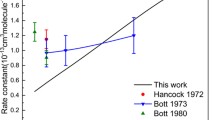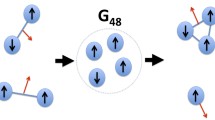Abstract
The collisional rotational transition probabilities for molecule-molecule and molecule-atom interactions in three-dimensional space are calculated. The quasiclassical approach developed in [1] is used. Expressions are obtained that are suitable for practical calculations of single-quantum and double-quantum rotational transitions in diatomic molecules. The collisional rotational transition probabilities are averaged over the Maxwell velocity distribution and their dependence on the gas temperature is obtained. To illustrate the method the results of a calculation of the probabilities for HCl-HCl, HCl-He, CO-CO interaction are presented.
Similar content being viewed by others
Literature cited
K. Takayanagi, “On the inelastic collision between molecules. I,” Prog. Theor. Phys.,8, No. 1, 111 (1952); K. Takayanagi, “On the inelastic collision between molecules. II,” Prog. Theor. Phys.,8, No. 5, 497 (1952); K. Takayanagi and T. Kishimoto, “On the inelastic collision between molecules. Ill,” Prog. Theor. Phys.,9, No. 6, 578 (1953); K. Takayanagi, “Vibrational and rotational transitions in molecular collisions,” Suppl. Prog. Theor. Phys., No. 25 (1963).
L. V. Leskov and F. A. Savin, “Relaxation of nonequilibrium gas systems,” Usp. Fiz. Nauk,72, No. 4, 741 (1960); M. N. Safaryan and E. V. Stupochenko, “Rotational relaxation of diatomic molecules in a light inert gas,” Zh. Prikl. Mekh. Tekh. Fiz., No. 4, 29 (1964); F. J. Zeleznik, “Rotational relaxation in polar gases,” J. Chem. Phys.,47, No. 9, 3410 (1967).
C. F. Curtiss and R. B. Bernstein, “Molecular collisions. IX. Restricted-wave approximation for rotational excitation and scattering of diatomic molecules,” J. Chem. Phys.,50, No. 3, 1168 (1968); R. W. Fenstermaker, C. F. Curtiss, R. B. Bernstein, “Molecular Collisions. X. Restricted-distorted-wave-born and first-order sudden approximations for rotational excitation of diatomic molecules,” J. Chem. Phys.,51, No. 6, 2439 (1969).
J. J. Everdij, J. I. V. Montfort, and N. F. Verster, “Half-classical calculation of rotational transitions,” Electron, and Atom. Collisions, Abstr. Paper 8 ICPEAC, Belgrad,1, 21 (1973); S. Saha, E. Guha, and A. K. Barua, “Rotational inelasticity in polar diatom-atom scattering: application of the semiclassical time-dependent perturbation theory to Ne-CO and Ne-HCl systems,”1, 84 (1973).
J. O. Hirschfelder, C. F. Curtiss, and R. B. Bird, Molecular Theory of Gases and Liquids, Wiley (1964); K. F. Herzfeld and T. A. Litovitz, Absorption and Dispersion of Ultrasonic Waves, Academic Press, New York (1959); V. B. Leonas, “Investigation of short-range intermolecular forces,” Usp. Fiz. Nauk,107, No. 1, 29 (1972).
Author information
Authors and Affiliations
Additional information
Translated from Zhurnal Prikladnoi Mekhaniki i Tekhnicheskoi Fiziki, No. 2, pp. 13–19, March–April, 1975.
The authors thank E. K. Kamalova for carrying out the computer calculations of the collisional rotational transition probabilities.
Rights and permissions
About this article
Cite this article
Vargin, A.N., Ganina, N.A., Konyukhov, V.K. et al. Calculation of the rotational transition probabilities of diatomic molecules when they collide with heavy particles. J Appl Mech Tech Phys 16, 163–167 (1975). https://doi.org/10.1007/BF00858907
Received:
Issue Date:
DOI: https://doi.org/10.1007/BF00858907




